#nasa james webb telescope first image joe biden full color jwst space nasa
Text

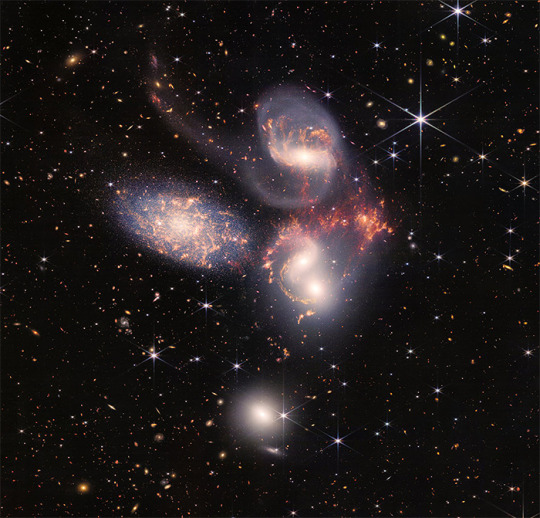


Look Beyond l Webb
This is beautiful....
#james webb space telescope#JWST#universe#tags dont work#science#stars#spacex#cosmos#photography#earth#james webb telescope#physics#jwst#nasa james webb telescope first image joe biden full color jwst space nasa#bigbang#supernova#james webb update#james webb deepest sharpest view of universe#nasa#space#astrophotography#nebula#planets#ring nebula#astronomy#galaxy#smacs 0723#outer space#black holes
2K notes
·
View notes
Text
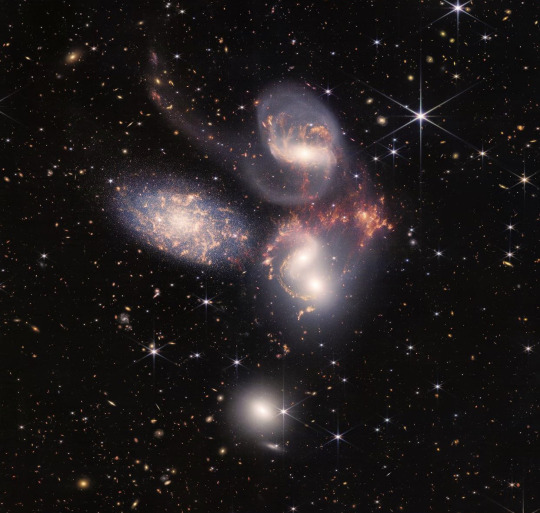
via NASA, Stephan’s Quintet
#sobbing#GORGEOUS#galaxies#stars#space#space!!#nasa james webb telescope first image joe biden full color jwst space nasa#james webb images#james webb telescope#james webb space telescope#astronomy#nasa#astrophysics#poseidonsarmoury#dark academia#dark academia aesthetic#books & libraries#light academia#light academia aesthetic#dark academic aesthetic#galaxy cluster#dark academic#chaotic academia#chaotic academia aesthetic#aesthetic#jwst
1K notes
·
View notes
Text
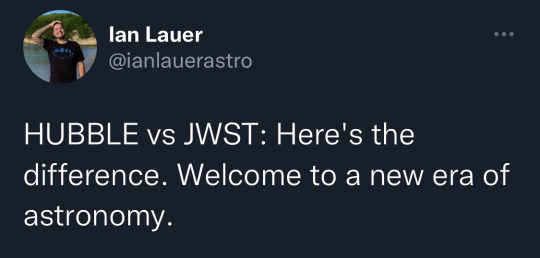


SPACS 0723 (galaxy cluster within southern constellation of Volans) by Hubble Space Telescope vs James Webb Space Telescope
some facts about SPACS!
the light in this picture is from about 4.6 billion years ago, which is within a billion years of the big bang (wild)
the picture was made with a composite of images at different wavelengths (like a long exposure picture), which took the James Webb Telescope about 12.5 hours, compared to Hubble Telescope’s two weeks (omg)
the constellation is visible from earth! but only if you live in the southern hemisphere lol
the colors from the JWST picture tell us which galaxies have stars and very little dust (blue), are enshrouded in thick layers of dust (red), or have lots of hydrocarbons and other chemical compounds (green)
as a magnifying glass can warp perception, some of the blurred/distorted galaxies from JWST’s image are caused by light bending around more powerful galaxy clusters that are in front of them
all credit for this info goes to nasa! i am just a space enthusiast that wanted to share ✰・゚: *
#not mine#i just reposted pics for better quality n viewing#twitter to tumblr#james webb telescope#nasa james webb telescope first image joe biden full color jwst space nasa#jwst#nasa#hubble telescope#james webb space telescope#space#galaxies#astronomy#stars#science#moon aesthetic#deep space#i’m sorry i just rly love space
92 notes
·
View notes
Text
To some, it looks like a wheel of a cart. In fact, because of its outward appearance, the presence of a central galaxy, and its connection with what looks like the spokes of a wheel, the galaxy on the right is known as the Cartwheel Galaxy. To others, however, it looks like a complicated interaction between galaxies awaiting explanation. Along with the two galaxies on the left, the Cartwheel is part of a group of galaxies about 500 million light years away in the constellation Sculptor. The large galaxy's rim spans over 100,000 light years and is composed of star forming regions filled with extremely bright and massive stars. The Cartwheel's ring-like shape is the result of gravitational disruption caused by a smaller galaxy passing through a large one, compressing the interstellar gas and dust and causing a star formation wave to move out like a ripple across the surface of a pond. The featured recent image of the Cartwheel Galaxy by the Webb Space Telescope reveals new details not only about where stars are forming, but also about activity near the galaxy's central black hole.
📷 NASA/ESA/CSA/STScI/Webb ERO Production Team
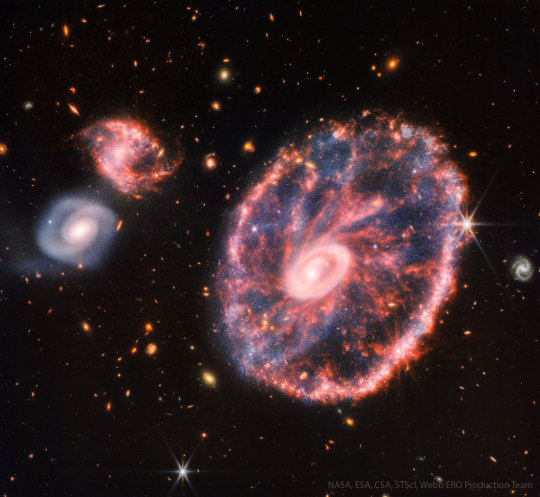
#science#news#outer space#astronomy#space science#universo#space exploration#astronomy news#research#space#james webb space telescope#nasa james webb telescope first image joe biden full color jwst space nasa
20 notes
·
View notes
Text
Hubble vs JWST

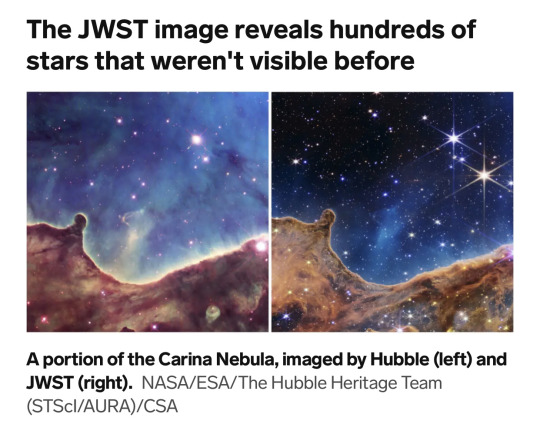
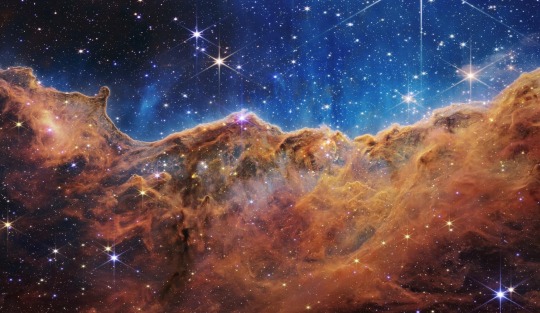




#space#outterspace#nasa james webb telescope first image joe biden full color jwst space nasa#JWST#stars#astronomy#galaxy#galaxies#amazing
13 notes
·
View notes
Text
7 Crazy facts about james webb telescope

1. Look back in time with Webb
The James Webb Telescope will help astronomers not only look farther out into space, but will also take us back in time.
2. James Webb's "golden mirror"
The new telescope is at least 100 times more powerful than the Hubble Telescope. And with its golden mirror, astronomers are hoping to catch glimpses of the universe like never before.
3. A better understanding of our universe's history
All images taken by Hubble reflect not only galactic systems but also a collection of the universe's history.
4. Understanding the dark ages of cosmos
Before the first starlight appeared in the universe, the whole universe was essentially covered in a primordial gas of sorts, which has led to this era being called the "cosmic dark ages".
5. Infrared lighting
While the Hubble telescope collects images in mostly ultraviolet (visible) light, James Webb will mostly take pictures in infrared, revealing more detail about the objects in those images unlike ever before.
6. The telescope will deploy itself in space
scientists decided it was best to fold the telescope inside a rocket which will then be deployed far away from Earth in space.
7. The distance from Earth is huge
While Hubble was only 547 kilometres away from Earth, the James Webb Telescope will be millions of kilometres away from Earth - roughly four times the distance between the Earth and Moon
#science#galaxies#astronomy#NASA#Universe#cosmos#solar system#planets#jwst#nasa james webb telescope first image joe biden full color jwst space nasa#james webb space telescope
7 notes
·
View notes
Text
Pillars of Creation Spotted By JWT
The Pillars of Creation are dense clouds of hydrogen gas and dust in the Serpens constellation, which are 6,500 light-years away from Earth. They lie in the Messier 16 nebula, which is an active star forming region.
Every large telescope has captured this scene, including the most famous image produced by the Hubble observatory in 1995 and 2014. The Webb telescope has infrared detectors, and is therefore able to do what other telescopes cannot, and see past the light scattering caused by the pillars’ dust to image the activity of new born suns (below).

"I've been studying the Eagle Nebula since the mid-1990s, trying to see 'inside' the light-years long pillars that Hubble showed, searching for young stars inside them. I always knew that when James Webb took pictures of it, they would be stunning. And so they are," Prof Mark McCaughrean, the Senior Advisor for Science at the European Space Agency, told BBC News.
The pillars are illuminated and sculpted by ultraviolet light from nearby stars, but at the same time, the radiation from the stars is dismantling the pillars. Actually, if you were able to travel faster than light and teleport to their location, the pillars probably wouldn’t even be there anymore. The light that reached the Webb telescope has taken 6,500 years to reach its mirrors, and therefore we’re seeing them in the past.
Source (of image and information): BBC News, written by Jonathan Amos
Image credit: Nasa
#science#science communication#scicomm#stem#science education#space#astrophysics#physics#nasa james webb space telescope jwst raw data spectacular pictures spiral galaxies nasa#nasa james webb telescope first image joe biden full color jwst space nasa#jwst images#pillars of creation
5 notes
·
View notes
Text
So everything is awful, but at least NASA is out here doing great stuff. Have you seen the James Webb Space Telescope pictures? Amazing.
#NASA#nasa james webb telescope first image joe biden full color jwst space nasa#jwst#james webb telescope#space#stars#galaxy
5 notes
·
View notes
Text


#james webb space technology#james webb space telescope#nasa earth#nasa hubble space telescope#nasa james webb telescope first image joe biden full color jwst space nasa#nasa picture of the day#astronomy#space#jwst#hubble
2 notes
·
View notes
Photo

Where, Exactly, Do You Stand In Our Galaxy?
The place you are standing occupies a spot on this planet. The field the farmer plows stretches across some of the surface. The coastline the fisherman sails around goes from here to there. All these demonstrate the traditional need for maps. Where you are, how far you have to go, and in what direction; these are critical issues for us as we undertake our normal lives.
As man explored our planet Earth, we always sent cartographers (a fancy word for mapmakers) out into the unknown first. Lewis & Clark, Magellan, Drake, Humboldt, Livingstone, Rondon… all these great explorers had one thing uppermost in their minds: map what you see so you can explain it all back home, in order to open up a new frontier, so you can open up the future to everybody.
22 years ago, a most extraordinary mapping expedition took place. For the first time, in one continuous sweep, the surface and depth (of the oceans) of our planet were mapped from space with an instrument that was perhaps 10,000 times more accurate than any mapping tool used previously. Not since the late ‘60s when we saw our planet for the first time as a whole (and learned it was a bit pear-shaped; glowing blue and brown and white in the vastness of near space) has anyone ever caused such a stir with geographers, geologists, explorers and resource managers. The only one left out of this excitement 22 years ago was the general public.
The NASA mapping mission during a Shuttle flight was a bit of a ho-hum to the general public. What was wrong is that the media didn’t understand what was going on. After all, who needs a better map, we have road maps, we have air charts, and we have sea charts? What resulted, however, was a detailed map of your home planet as you – and most scientists – only guessed at: a planet full of new promise, unexplored, un-dreamed of resources and, most of all, a one-time global understanding of where and with what we humans live.
The mapping that the Shuttle completed was like a whole-earth catalogue, a whole-earth census of the planet we live on. Like the cartographers of old, those Astronauts completed an amazing task, one that opened up our understanding of the planet on which we live.
And that need to know what we have, what possibilities exist is now being stretched to our solar system and galaxy. This need is the reason for the Hubble Space Telescope and, amazingly, the newer James Webb Space Telescope, which is a hundred times more powerful. Those beautiful images you see, far beyond anything you may have imagined, are exactly the same as a new Lewis & Clark expedition, Humboldt’s or Drake’s voyages. The James Webb Space Telescope is creating a map for mankind’s future exploration.
That’s what your space dollar is being spent on: Great map-making and eventual human exploration that your children will learn about in school, right up there alongside Drake, Vasco de Gama, Cook, Lewis and Clark.
0 notes
Photo

PRADA Experiment By me
( IG iammanjiit )
#prada#star#stars#nasa picture of the day#nasa james webb telescope early projects jwst space discovery history james webb#nasa james webb telescope first image joe biden full color jwst space nasa#nasa#brand#brands#brando#prada brand
1 note
·
View note
Text

Jupiter, and its moon Europa, left, are seen through Webb’s NIRCam instrument 2.12 micron filter
James Webb telescope.
Image credits: @nasa
#space#spacex#galaxies#black holes#outer space#galaxy#jupiter#moon#james webb space telescope#jwst#nasa james webb telescope first image joe biden full color jwst space nasa#james webb images#james webb telescope#james webb first full colour image#planets#planet
243 notes
·
View notes
Text

via NASA, Carina Nebula
#poseidonsarmoury#james webb images#james webb telescope#james webb space telescope#nasa james webb telescope first image joe biden full color jwst space nasa#nasa#carina nebula#nebula#space#galaxy#galaxies#dark academia#dark academia aesthetic#books & libraries#light academia#light academia aesthetic#dark academic aesthetic#dark academic#chaotic academia#image reveal#Astronomy#astrophysics#space!!#jwst
467 notes
·
View notes
Text
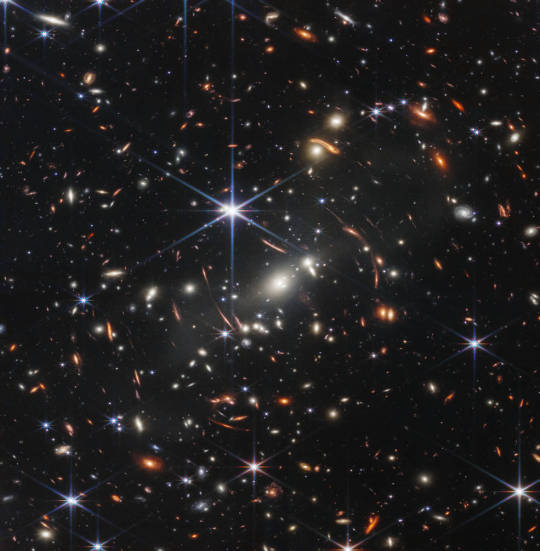
1 note
·
View note
Text
Two galaxies are squaring off in Virgo and here are the latest pictures. When two galaxies collide, the stars that compose them usually do not. This is because galaxies are mostly empty space and, however bright, stars only take up only a small fraction of that space. But during the collision, one galaxy can rip the other apart gravitationally, and dust and gas common to both galaxies does collide. If the two galaxies merge, black holes that likely resided in each galaxy center may eventually merge. Because the distances are so large, the whole thing takes place in slow motion -- over hundreds of millions of years. Besides the two large spiral galaxies, a smaller third galaxy is visible on the far left of the featured image of Arp 274, also known as NGC 5679. Arp 274 spans about 200,000 light years across and lies about 400 million light years away toward the constellation of Virgo.
📷: NASA, ESA, Hubble; Processing & Copyright: Mehmet Hakan Özsaraç
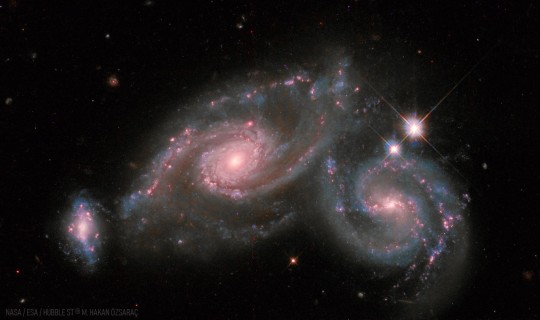
#science#universo#astronomy#outer space#news#space science#space exploration#astronomy news#space#research#nasa breaking news#nasa james webb telescope first image joe biden full color jwst space nasa
3 notes
·
View notes
Text
The commentary and the whole shebang of the jwst is simply marvelous. And so unbelievable. God I love it
#james webb telescope#nasa james webb telescope first image joe biden full color jwst space nasa#jwst
0 notes